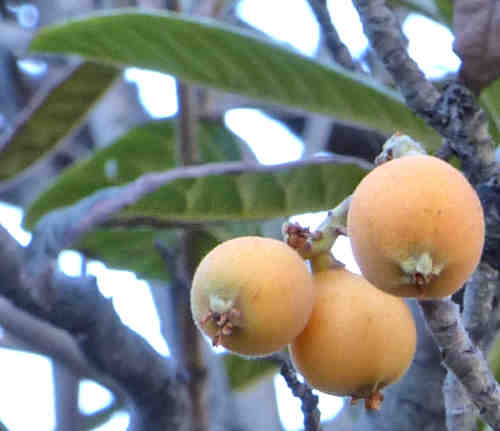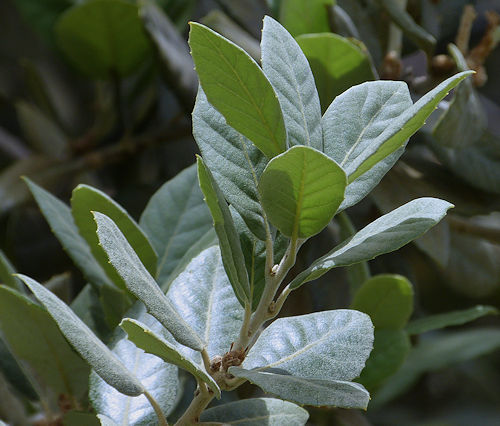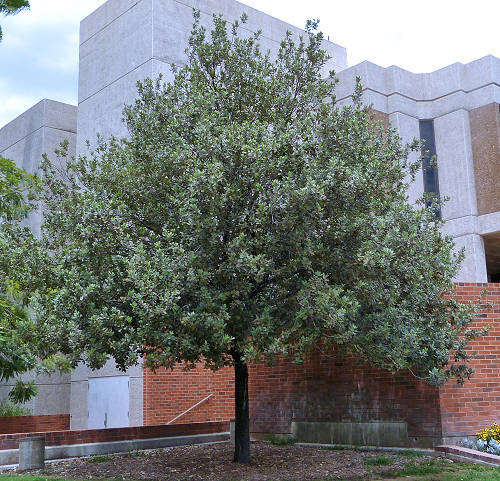Growing Loquat:
Eriobotrya japonica
Back to Fruit, Berries and Nuts
Botanical Overview
A member of the Rose family (Rosaceae), the Eriobotrya genus has Loquat as its only prominent species. There are over 800 cultivars of Loquat found around the world, of which less than 30 are widely grown.
Description
Form:
A large shrub or small tree.
Lifespan:
Over 100 years in ideal conditions.
Leaf retention:
Evergreen.
Growth rate:
Moderate.
Mature Size:
6-30' (1.8-9m) high and 5-25' (1.5-7.6m) wide. Some cultivars are grafted onto Quince
rootstock which produces a dwarf as small as 6' (1.8m) high.
Flowers:
White, fragrant, small, clustered at the ends of branches.
Bloom:
Fall to early winter. This tree tends to bloom heavily, then lightly, in alternate years.
Pruning excess blooms in heavy years may help even out the blooming cycles.
Self-fruitful:
Depends on cultivar. All cultivars do better with a companion as a pollinator, but most
cultivars commonly sold in nurseries are abundantly self-fruitful.
Years before fruiting:
Grafted 2-4, grown from seed 8-10.
Fruit:
Oval, round or pear-shaped, and 1-2" (2.5-5cm) long. The skin is smooth or downy, and yellow
to orange.
The flesh is white, yellow or orange, sweet to sour, and contains 1-5 brown seeds.
When eaten raw, it is common to peel the skin or scoop the flesh out of it.
Months for fruit to ripen:
3. The fruit are ripe when slightly soft.
Storage after harvest:
The soft fruit of many cultivars must be consumed immediately. A few cultivars produce fruit
lasting up to two weeks when refrigerated.
Leaves:
Dark green, glossy on top, whitish or rusty-hairy beneath, thick, stiff, prominent veins,
broadly elliptical to narrowly lance-shaped.
Stems:
No thorns.
Roots:
Most trees are grafted onto rootstock for quicker fruit production. Any loquat seedling
can be used as rootstock to produce a normal-sized tree. Quince rootstock is used to produce
dwarf cultivars.
Cultivars of Note:
'Big Jim' Large fruit, orange flesh, sweet-tart
flavor, 2-4 seeds, skin easy to peel, oblong to round shape, self fertile.
'Champagne' Whitish flesh, sweet, spicy flavor,
2 seeds, thin skin, pear shape, self fertile.
Wildlife:
The flowers attract bees. The fruit attracts birds and mammals. Dropped fruit should be removed
immediately.
Toxic / Danger:
All parts of this plant are mildly poisonous except ripe fruit and dried leaves. The seeds
are poisonous.
Origin:
China. It was introduced to Japan 2000 years ago.
Cultivation and Uses
USDA hardiness zones:
8b-10. The mature tree is hardy to 15°F (-9.4°C), but temperatures below 26°F
(-3.3°C) will kill flowers and cause fruit drop.
Flower buds may be able to withstand 20°F (-6.7°C). Fruit-bearing loquats are best
grown in citrus-producing regions and need some heat to mature a crop.
Being subtropical, they prefer mild winters and suffer in freezes or summer temperatures
over 90°F (32°C).
Chill hours:
None.
Heat tolerant:
This tree does best with extra water and afternoon shade above 90°F (32°C).
Drought tolerant:
Not in high temperatures.
Sun:
Full sun in the morning and part afternoon shade when temperatures are over 90°F
(32°C). The fruit of some cultivars are prone to purple-spot sunburn in high winter
temperatures with direct sun and may drop from the tree.
Planting:
Locate the tree where it can receive full morning sun with part shade in hot afternoons to
reduce water needs. There must be no danger of flooding where it is placed.
This tree can be grown as an ornamental in a large container.
Soil:
It needs very well draining, salt free soil, but is tolerant of soil types otherwise.
This plant does better in soil with pH 6.1-7.8 (slightly acidic to slightly alkaline).
Fertilize:
Apply organic fertilizer once a month in warm weather, inside the drip line
(under the branches), and 8" (21cm) away from the trunk.
Because loquat is sensitive to salt, organic, rather than chemical, fertilizer should be used.
Any fertilizer should have no more than 6% nitrogen if the tree is to flower.
This tree is prone to magnesium, manganese, and potassium deficiency in alkaline soil, and the symptoms resemble fire blight or salt burn. This can be treated with one tablespoon (15ml) each of magnesium sulfate and manganese sulfate in one gallon (4 liters) of water. Pour the water around the drip line of the tree once a month in warm weather. Every three months, also add one tablespoon (15ml) of potassium sulfate. Do not fertilize in winter.
This tree is prone to magnesium, manganese, and potassium deficiency in alkaline soil, and the symptoms resemble fire blight or salt burn. This can be treated with one tablespoon (15ml) each of magnesium sulfate and manganese sulfate in one gallon (4 liters) of water. Pour the water around the drip line of the tree once a month in warm weather. Every three months, also add one tablespoon (15ml) of potassium sulfate. Do not fertilize in winter.
Water after becoming established:
Deep water once or twice a week, depending on
temperature, when fruiting. This tree is flood intolerant. When the plant is over four years
old, water monthly when not fruiting.
While extra water helps the tree withstand full afternoon sun in high temperatures, afternoon
part or full shade can reduce water needs.
Mulch:
Apply organic mulch under the canopy, but 8" (21cm) away from the trunk, to reduce heat stress
and water loss, and prevent weeds.
First Three Years Care:
Young plants may need part shade all day in the hottest months until they are 8' (2.4m) high.
Water every other day for the first week. Water twice a week for the first couple of months.
Deep water every week after that for the first year. Water every two weeks in the second and
third years.
Prune:
Thin the fruit when they are marble-sized or smaller, leaving 4-6 fruits per terminal shoot.
This will allow the fruit to grow larger and avoid branch breakage.
Prune branches and stems just after harvest to reduce the number of terminal shoots, and to remove crossing branches. If the top of the tree does not receive full sun, prune to a lower height to facilitate fruit thinning and harvest.
Prune branches and stems just after harvest to reduce the number of terminal shoots, and to remove crossing branches. If the top of the tree does not receive full sun, prune to a lower height to facilitate fruit thinning and harvest.
Litter:
Fruit if not harvested.
Propagation:
Seed is used for ornamental plantings and rootstock but does not breed true. Cuttings from
desirable cultivars grafted onto rootstock are used for fruit production. Air layering works
better than rooted cuttings.
Pests:
Fire blight. Keep this tree away from other plants prone to fire blight such as apples, pears,
and pyracantha.
Uses: Ornamental, edible fruit (first peeled, then eaten
fresh, placed in fruit salad, or cooked into pies, jams and jellies). In Japan, the leaves are
commonly used to make a tea. There, the leaves are picked green, washed and their bottoms
scraped to remove fine hairs, then dried and cut for brewing.
Do you have additional information or a different experience for these plants that you would like to share? Email info@GardenOracle.com. All contributions are welcome and appreciated.




Latest update: August, 2024
© 2008-2025 by GardenOracle.com

